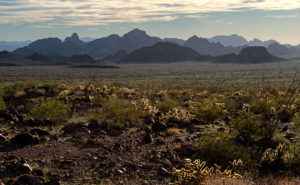The KofA Wildlife Refuge takes up a good chunk of land. It covers a megabyte—or 1040 square miles if you’re not a computer nerd and don’t get the joke—nearly the size of Rhode Island. The topography is Basin and Range, which is standard for western Arizona, Nevada, and California’s Mohave Desert. Finally—one last bit of trivia before I move on from statistics—the wildlife range spans three mountain ranges (that’s three more than in Rhode Island).

The reason for so much space is to support herds of desert bighorn and antelope. Fifty years ago, both of these large animals were almost gone. Like bison, the sheep were plentiful in western Arizona, but a century of overhunting took its toll. It’s actually the sheep’s fault. They walk to the edge of a precipice then strike a magnificent pose saying, “Go on and shoot. I won’t move, and I’ll bet you’ll miss.” It was a living shooting gallery. By the time Arizona was a state, they were effectively wiped out.
Things started to change in 1933 when the Boy Scouts worked to get a game range established. Although the idea seems convoluted, you can’t hunt big horn without having sheep—the very logic that started the conservation movement. The game management people augmented the herds with transplants from other areas—including Mexico, but there was too much inbreeding. To successfully reintroduce them, they needed a broader gene base with multiple herds. Wildlife scientists established a crowd in the KofA and a southern pack in the Castle Domes and another in the New Water range to the north. To make this system work young males need to migrate across the open desert between ranges and breed with a different stock. Sheep can’t move freely across an Interstate Highway. Now you know why the KofA management area is so large. We like sheep, however rattlesnakes are a different thing.
When I set up to photograph this week’s featured image, none of what I told you was in my head. I thought it was pretty. That’s all I need to take a picture. I made it late in the day while driving away from Palm Canyon looking south. On the far side of King Valley, the Castle Dome Mountains are back-lit from the low winter sun. The atmospherics show off the range’s depth, as the peaks progressively get lighter in the distance, with Castle Dome Peak rising to 3788 feet. As I processed this image, I began to understand its story. I called it Winter Castle, and I hope you like it.
As usual, you can see a larger version of Winter Castle on its Web Page by clicking here. I hope you enjoy viewing this week’s post and return next week when we’ll show another featured image from the KofA Wildlife Refuge.
Until next time — jw

Truly Beautiful!